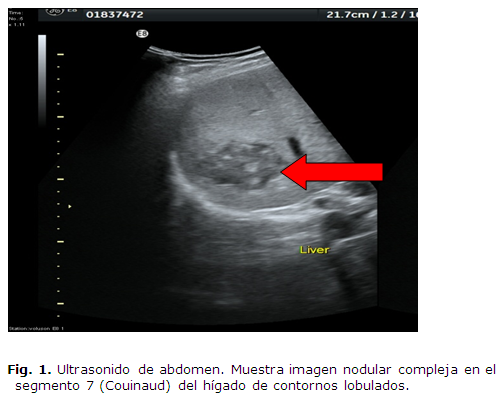An atypical presentation of amoebic hepatic abscess
Keywords:
Entoamebahistolytica, Absceso hepático.Abstract
Introduction: amoebic hepatic abscess is the extraintestinal manifestation of an infection by entamoeba histolytica. Estimations are made that 10% of the world population has been infected by the parasite, being more frequent in tropical regions, where overcrowding and bad sanitary conditions occur. Africa, Latin America, Southeast Asian and India have considerable health problems, resulting from this disease. In Cuba amebiasis has been proved not to be one of the most frequent parasitism cases.Case presentation: male patient of age 48 years and of Indian nationality, presenting clinical findings, which proves a unique lesion in the right liver lobule, diagnosed by ultrasound scan and nuclear magnetic resonance. The presence is confirmed of serum antibodies against entamoeba histolytica. Treatment with metronidazole produced clinical and radiological improvement.
Conclusions: atypical clinical presentation constitutes a remarkable element worthy considered in daily clinical practice.
Downloads
References
1. Sharma N, Sharma A, Varma S, Lal A, Singh V. Amoebic liver abscess in the medical emergency of a North Indian hospital. BMC Research Notes[internet]. 2010[cited january 2014]; 3:21. Available from: http://link.springer.com/article/10.1186%2F1756-0500-3-21#page-1
2. Mukhopadhyay M, Saha A K, Sarkar A, Mukherjee S. Amoebic liver abscess: presentation and complications. Indian J Surg[internet]. 2010[cited january 2014]; 72(1): 37-41. Available from: http://www.ncbi.nlm.nih.gov/pmc/articles/PMC3452541/
3. Albenmousa A, Sanai FM, Mohammed A, Babatin MA, Al Zanbagi AA, Al-Otaibi MM, Khan AH, Bzeizi KI. Liver abscess presentation and management in Saudi Arabia and the United Kingdom. Ann Saudi Med[internet]. 2011[cited january 2014]; 31(5): 528-532. Available from: http://www.ncbi.nlm.nih.gov/pmc/articles/PMC3183690/
4. Castellanos Fernández M, González López ME, Lazo de Vallín S, Mandado S, Cañete R, Elvirez Gutiérrez A. Absceso hepático amebiano, a propósito de dos casos. Rev Panamericana de Infectologia. 2005; 7(2):39-42.
5. Haque R, Kabir M, Noor Z, Rahman SM, Mondal D, Alam F, Rahman I, Al Mahmood A, Ahmed N, Petri WA Jr. Diagnosis of amebic liver abscess and amebic colitis by detection of Entamoeba histolytica DNA in blood, urine, and saliva by real-time PCR assay. J Clin Microbiol[internet]. 2010[cited january 2014]; 48(8): 2798–2801. Available from: http://jcm.asm.org/content/48/8/2798.full
6. Gajardo MF, Flisfisch H. Absceso hepático. Rev Medicina y Humanidades[internet]. 2010[cited january 2014]; 2(2-3): 51-55. Available from: http://www.medicinayhumanidades.cl/ediciones/n2_32010/10_%20ABSCESO_HEPATICOS.pdf
7. Gonzáles M LM, Dans LF, Martínez EG. Antiamoebic drugs for treating amoebic colitis. The Cochrane Library. 2009[cited january 2014]; 2. Available from: http://www.thecochranelibrary.com/userfiles/ccoch/file/Water%20safety/CD006085.pdf

Published
How to Cite
Issue
Section
License
Authors who have publications with this journal agree to the following terms: Authors will retain their copyrights and grant the journal the right of first publication of their work, which will be publication of their work, which will be simultaneously subject to the Creative Commons Attribution License (CC-BY-NC 4.0) that allows third parties to share the work as long as its author and first publication in this journal are indicated.
Authors may adopt other non-exclusive license agreements for distribution of the published version of the work (e.g.: deposit it in an institutional telematic archive or publish it in a volume). Likewise, and according to the recommendations of the Medical Sciences Editorial (ECIMED), authors must declare in each article their contribution according to the CRediT taxonomy (contributor roles). This taxonomy includes 14 roles, which can be used to represent the tasks typically performed by contributors in scientific academic production. It should be consulted in monograph) whenever initial publication in this journal is indicated. Authors are allowed and encouraged to disseminate their work through the Internet (e.g., in institutional telematic archives or on their web page) before and during the submission process, which may produce interesting exchanges and increase citations of the published work. (See The effect of open access). https://casrai.org/credit/


